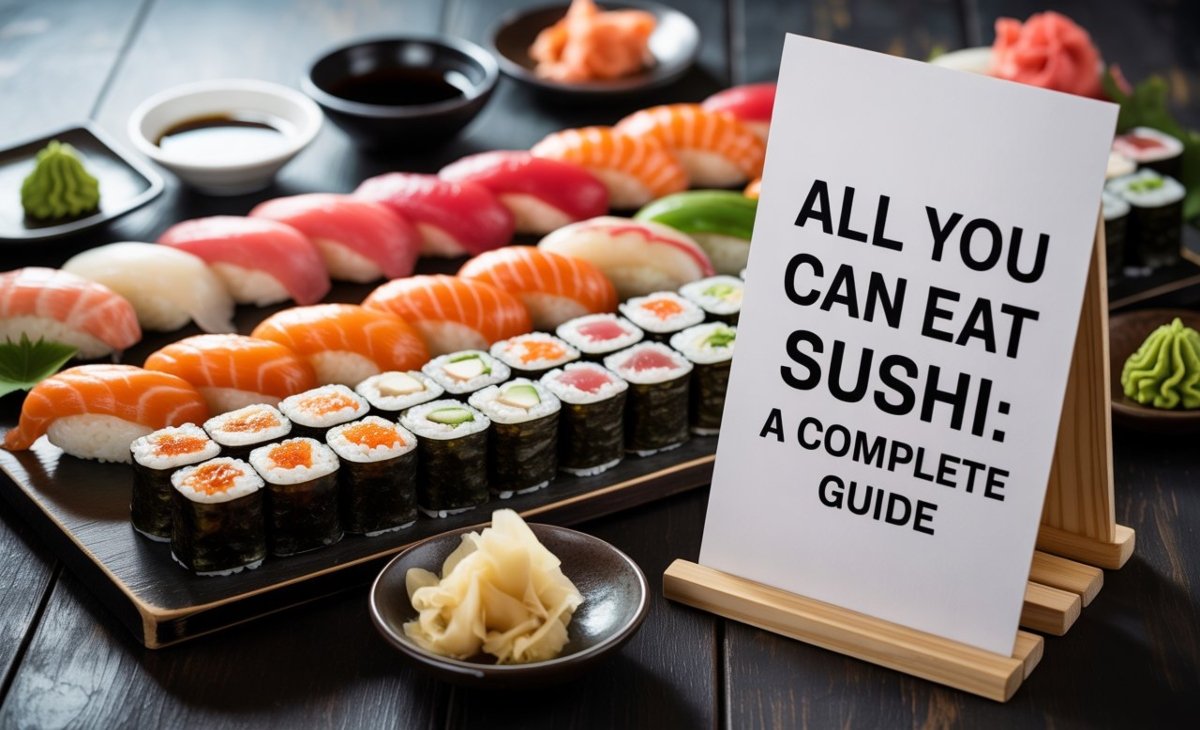There’s something magical about sitting down to a table filled with endless sushi rolls, sashimi, and nigiri. For sushi lovers, the concept of all you can eat sushi feels like a dream come true. Instead of choosing just one or two rolls, you can try a wide variety of flavors without worrying about the cost per piece.
But if you’ve never been to one of these restaurants, you might wonder: How does it work? Is it worth the price? What should I expect? In this guide, we’ll dive into everything you need to know about all you can eat sushi—from its history and costs to tips, etiquette, and even health considerations.
What Is All You Can Eat Sushi?
At its core, all you can eat sushi is a dining option where you pay a fixed price and eat as much sushi as you want.
There are usually two styles:
- Buffet-style: Sushi is pre-made and displayed on trays. Diners serve themselves, similar to a typical buffet.
- Made-to-order: Customers order from a special menu, and dishes are freshly prepared in smaller portions.
Most modern sushi restaurants prefer the made-to-order system, which ensures freshness and reduces waste.
The History of All You Can Eat Sushi
Sushi itself has a long history in Japan, evolving from simple fermented rice and fish to the beautifully crafted rolls we know today. But the concept of all you can eat sushi is more of a Western innovation.
In Japan, sushi is often considered an art form, with chefs spending years perfecting their craft. However, as sushi became popular in North America and Europe, demand grew for affordable, casual dining options. Restaurants began offering flat-rate menus to attract sushi fans who wanted more variety without breaking the bank.
By the 1990s, all you can eat sushi had become a common concept in the U.S. and Canada, especially in areas with large Japanese communities. Today, it’s a staple in many cities worldwide, combining affordability with indulgence.
Why All You Can Eat Sushi Matters
The popularity of all you can eat sushi isn’t just about eating more—it’s about the experience.
- Value for Money: Ordering individual rolls can add up quickly, often $12–$18 each. With an AYCE menu, you can try a wide variety for a fixed price.
- Variety and Exploration: It’s a chance to step outside your comfort zone and try new rolls or nigiri without the fear of wasting money.
- Social Dining: Sushi is best enjoyed with friends or family, and AYCE restaurants encourage sharing and experimenting together.
- Cultural Experience: Even though AYCE sushi is often Westernized, it still introduces diners to Japanese flavors, traditions, and ingredients.
Cost Breakdown: How Much Does All You Can Eat Sushi Cost?
The price of all you can eat sushi varies depending on location, quality, and menu options.
- Lunch prices: Typically range from $20–$30 per person.
- Dinner prices: Slightly higher, usually $25–$40 per person.
- Premium upgrades: Some restaurants charge extra for sashimi, specialty rolls, or seasonal items.
Regional Variations
- Big Cities (New York, Los Angeles, Toronto): Expect to pay more due to higher overhead and demand.
- Smaller Towns/Suburbs: Often more affordable, with promotions to attract repeat customers.
- Las Vegas: Known for extravagant AYCE sushi spots, often paired with unique rolls you won’t find elsewhere.
How All You Can Eat Sushi Works
If you’re new to AYCE sushi, here’s what to expect:
- You pay a flat fee. Lunch is cheaper than dinner, and kids’ pricing may be available.
- You receive a special menu. These menus are usually different from the regular à la carte offerings.
- You order in rounds. Start small, eat what you order, then request more.
- There’s a waste policy. Most places charge extra for uneaten food to discourage waste.
- You eat until satisfied. Take your time—sushi rice is filling, and rushing might leave you too full too soon.
Health Considerations of All You Can Eat Sushi
While all you can eat sushi is fun, it’s important to balance enjoyment with health.
- Mercury Levels: Some fish like tuna contain higher mercury levels. Eating them in moderation is best.
- Sodium Intake: Soy sauce and miso soup add a lot of salt, which can lead to bloating.
- Rice Overload: Sushi rice is seasoned with sugar and vinegar. Eating too much can be heavy on carbs.
- Raw Fish Safety: Restaurants must follow strict safety standards, but sensitive individuals should be cautious.
Health Tip: Balance raw fish with vegetable rolls, miso soup, and fresh sashimi to enjoy a healthier AYCE experience.
Best Cities for All You Can Eat Sushi
Some cities have become hotspots for all you can eat sushi due to strong food cultures and diverse populations.
- Las Vegas: Famous for extravagant buffets and sushi spots offering unlimited premium rolls.
- Los Angeles: Huge Japanese-American community means plenty of high-quality AYCE sushi restaurants.
- Toronto & Vancouver: Canadian cities known for excellent sushi at affordable AYCE prices.
- New York City: Offers everything from budget AYCE sushi to luxury versions with premium ingredients.
If you’re traveling, check local reviews—hidden gems often provide better value than tourist-heavy locations.
How to Choose the Right All You Can Eat Sushi Restaurant
Not all AYCE spots are created equal. Here’s how to find the best ones:
- Check freshness: Good restaurants prepare food in small batches, not piles.
- Read reviews: Look for mentions of quality fish, attentive service, and fair waste policies.
- Inspect cleanliness: A clean dining area usually reflects care in the kitchen.
- Menu variety: A good AYCE spot should offer rolls, nigiri, appetizers, and maybe even sashimi.
Red Flags: Overly cheap prices, fish that looks dull, or pre-made rolls sitting out too long.
Tips and Etiquette for Enjoying All You Can Eat Sushi
Pace Yourself
Don’t rush. Eat slowly, sip tea or water, and give your body time to recognize fullness.
Order in Small Rounds
Start with one or two rolls. If you’re still hungry, order more. This reduces waste and ensures fresh sushi each time.
Try New Things
AYCE is the perfect time to try unfamiliar rolls or nigiri without worrying about cost.
Share with Friends
Going with a group lets you sample more dishes without filling up too quickly.
Be Respectful
Don’t waste food, don’t play with chopsticks, and thank your servers. Following etiquette makes the experience enjoyable for everyone.
Conclusion
For sushi fans, all you can eat sushi is more than just a way to eat—it’s an experience. From its roots as a Western dining trend to its current popularity worldwide, AYCE sushi offers variety, value, and fun.
Whether you’re in Las Vegas trying extravagant rolls, or at a cozy suburban spot with friends, knowing the costs, rules, and tips ensures you get the most from your meal. Just remember to pace yourself, try new flavors, and savor the moment.
Next time you’re craving sushi, skip the à la carte menu and discover the excitement of all you can eat sushi—you might just find your new favorite dining tradition.
Common Questions About All You Can Eat Sushi
1. Is the quality lower at AYCE sushi restaurants?
Not always. Many made-to-order AYCE restaurants provide excellent quality, sometimes equal to à la carte menus.
2. Can I get sashimi in an AYCE deal?
Some places include sashimi, while others limit it or charge extra. Always check the fine print.
3. Why do restaurants charge for leftover sushi?
To prevent waste. Over-ordering drives costs up and hurts both the restaurant and the environment.
4. How much sushi is too much?
Most people feel full after 8–12 rolls or a mix of nigiri and appetizers. The goal isn’t to overeat—it’s to enjoy.





